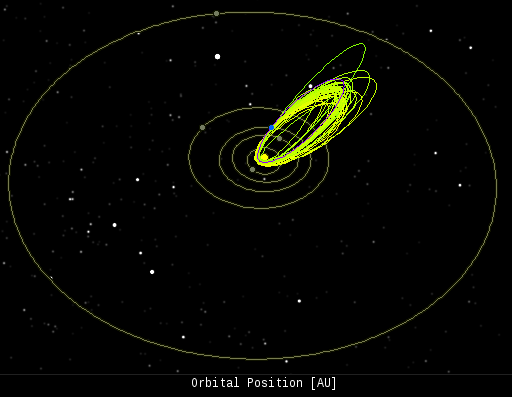Spaceweather.com
by Dr. Tony Phillips.GEMINID METEOR SHOWER--IT'S UNDERWAY:
This sharp uptick in activity signals the official beginning of the 2013 Geminid meteor shower. For the next 3 to 4 days, Earth will pass through a stream of debris from rock comet 3200 Phaethon, producing dozens of meteors per hour flying out of the contellation Gemini. "There is a nice show going on right now," says Bill Cooke, head of NASA's Meteoroid Environment Office.
The multiple cameras of NASA's fireball network are able to measure the orbits of Geminid meteoroids. This plot shows the orbits of the 39 fireballs recorded so far this week:
Earth is the blue dot where all the orbits intersect. The purple curve shows the path of Geminid parent 3200 Phaethon.
Forecasters
expect the shower to peak on Dec. 13-14 when Earth passes through the
busiest part of Phaethon's debris stream. Peak rates could reach 120
meteors per hour. However, glare from the nearly-full Moon could reduce
the number of visible meteors 2- to 3-fold. Cooke advises looking during
the hours just before local sunrise on Saturday, Dec. 14th. "At that
time, the Moon will be below the horizon, improving your chances of
seeing the show."
You can listen to radar echoes from the Geminids, unaffected by moonlight, on Space Weather Radio. Also, tune into NASA's live web chat about the Geminids on Friday the 13th beginning at 11 pm EST......
Geminid meteor shower will light up Friday night sky
More than 100 meteors will rocket across the sky on the night of Dec. 13 and early morning hours of the 14th. Visible from almost any point on Earth, it’s the peak of the annual Geminid meteor shower.
The most intense meteor shower of the year, the Geminid features between 100 and 120 meteors per hour at its peak, traveling about 78,000 miles per hour. The full shower lasts from Dec. 12-16.
"The Geminids are my favorite because they defy explanation," said Bill Cooke, lead for NASA’s Meteoroid Environment Office, in a press release. "Of all the debris streams Earth passes through every year, the Geminids are by far the most massive. When we add up the amount of dust in the Geminid stream, it outweighs other streams by factors of 5 to 500."
While most meteor showers are a collection of meteorids spewed from comets, the Geminid meteor shower features fragments and dusty debris of a “weird rocky object named 3200 Phaethon,” according to NASA.
Read More Here
.....









No comments:
Post a Comment
Hello and thank you for visiting my blog. Please share your thoughts and leave a comment :)